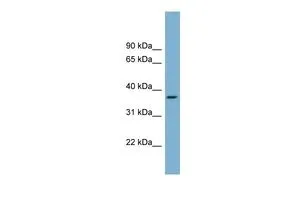
WB analysis of human fetal small intestine tissue using GTX46709 OR2W5 antibody at 0.2-1microg/ml.
OR2W5 antibody, Internal
GTX46709
Overview
- SupplierGeneTex
- Product NameOR2W5 antibody, Internal
- Delivery Days Customer9
- Application Supplier NoteWB: 0.2-2.5 ug/ml. *Optimal dilutions/concentrations should be determined by the researcher.Not tested in other applications.
- ApplicationsWestern Blot
- CertificationResearch Use Only
- ClonalityPolyclonal
- Concentration0.5-1 mg/ml
- ConjugateUnconjugated
- Gene ID441932
- Target nameOR2W5P
- Target descriptionolfactory receptor family 2 subfamily W member 5 pseudogene
- Target synonymsolfactory receptor 2W5; olfactory receptor, family 2, subfamily W, member 5; OR2W5; OST722; putative olfactory receptor 2W5
- HostRabbit
- IsotypeIgG
- Protein IDA6NFC9
- Protein NamePutative olfactory receptor 2W5
- Scientific DescriptionOlfactory receptors interact with odorant molecules in the nose, to initiate a neuronal response that triggers the perception of a smell. The olfactory receptor proteins are members of a large family of G-protein-coupled receptors (GPCR) arising from single coding-exon genes. Olfactory receptors share a 7-transmembrane domain structure with many neurotransmitter and hormone receptors and are responsible for the recognition and G protein-mediated transduction of odorant signals. The olfactory receptor gene family is the largest in the genome. The nomenclature assigned to the olfactory receptor genes and proteins for this organism is independent of other organisms. This olfactory receptor gene has a coding sequence that is comparable in length to other olfactory receptor genes, but it should be noted that a frameshift is present in the 3 coding region that disrupts the 7-transmembrane domain structure in the protein. It is unclear if the protein can function as an olfactory receptor or if an alternate function is served. For this reason, this gene has also been interpreted to be a pseudogene. [provided by RefSeq, Jan 2010]
- ReactivityHuman
- Storage Instruction-20°C or -80°C,2°C to 8°C
- UNSPSC12352203
